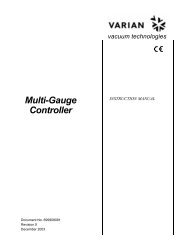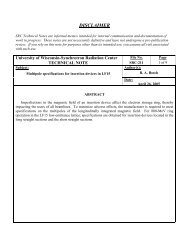SRC Users' Meeting - Synchrotron Radiation Center - University of ...
SRC Users' Meeting - Synchrotron Radiation Center - University of ...
SRC Users' Meeting - Synchrotron Radiation Center - University of ...
Create successful ePaper yourself
Turn your PDF publications into a flip-book with our unique Google optimized e-Paper software.
Exploratory Experiments: Photodetachment <strong>of</strong> Negative Ions<br />
by Energetic Photons<br />
Thomas Kvale 1 , Song Cheng 1 , David Seely 2 , and Jeffrey Thompson 3<br />
1<br />
The <strong>University</strong> <strong>of</strong> Toledo, Toledo, OH 43606<br />
2 Albion College, Albion, MI 49224<br />
3<br />
The <strong>University</strong> <strong>of</strong> Nevada, Reno, NV 89557<br />
Abstract<br />
One <strong>of</strong> the current investigations in Atomic Physics is the electron-electron interaction in<br />
atoms by placing atoms in "exotic" states. A unique opportunity exists to perform a series <strong>of</strong><br />
experiments which will probe this interaction by examining continuum states in various atomic<br />
species by photodetaching negative ions. <strong>Synchrotron</strong> radiation is useful in providing a<br />
continuously tunable source <strong>of</strong> photons over the energy range <strong>of</strong> interest. Various theories [1, 2]<br />
predict the photodetachment cross sections are rich in features (both minima and resonances) in this<br />
photon energy range. This situation makes these studies ideally suited for providing stringent tests<br />
<strong>of</strong> our current understanding <strong>of</strong> atomic structure. The specific experiments listed in this abstract are<br />
representative <strong>of</strong> the types <strong>of</strong> experiments possible and are only the first in an extended series <strong>of</strong><br />
experiments that are currently <strong>of</strong> great interest in atomic physics.<br />
The first series <strong>of</strong> experiments that are proposed will probe the photon energy region from<br />
4eV to 20 eV in a variety <strong>of</strong> relatively light elements. Gribakin, et al. [1] predicted the<br />
photodetachment cross sections for the outer np and nearby ns subshells <strong>of</strong> C - 2p 34 S, Si - 3p 34 S, and<br />
Ge - 4p 34 S. The np photodetachment cross sections have minima around 5eV above the negative ion<br />
ground states and then rise to maxima at around 8 eV before gradually falling again. The minima<br />
have widths <strong>of</strong> order <strong>of</strong> 0.5 eV, whereas the maxima have widths <strong>of</strong> several eV. By contrast, most<br />
<strong>of</strong> the predicted [2] resonances<br />
in Be - ( 4 P o , 4 D o , and 4 S o ) have<br />
widths <strong>of</strong> order <strong>of</strong> 10-50 meV.<br />
These proposed experiments<br />
complement previous<br />
photodetachment experiments <strong>of</strong><br />
the authors at lower photon<br />
energies. With an estimated<br />
photon flux <strong>of</strong> 10 12 photon/s, an<br />
ion current <strong>of</strong> 100 nA, and the<br />
predicted photodetachment cross<br />
sections, we expect a<br />
photoelectron current <strong>of</strong><br />
approximately 10-1000 e - /s. An<br />
apparatus (PHOTO-2) has been<br />
constructed for conducting this<br />
series <strong>of</strong> photodetachment<br />
experiments (see Figure).<br />
Briefly, it consists <strong>of</strong>: a 0 - 50kV negative ion accelerator; a dodecapole chamber for merging the<br />
ion and photon beams; an interaction chamber <strong>of</strong> approximately 30 cm long; and data acquisition<br />
chamber. Photodetached electrons are energy analyzed by a hemispherical energy analyzer located
















